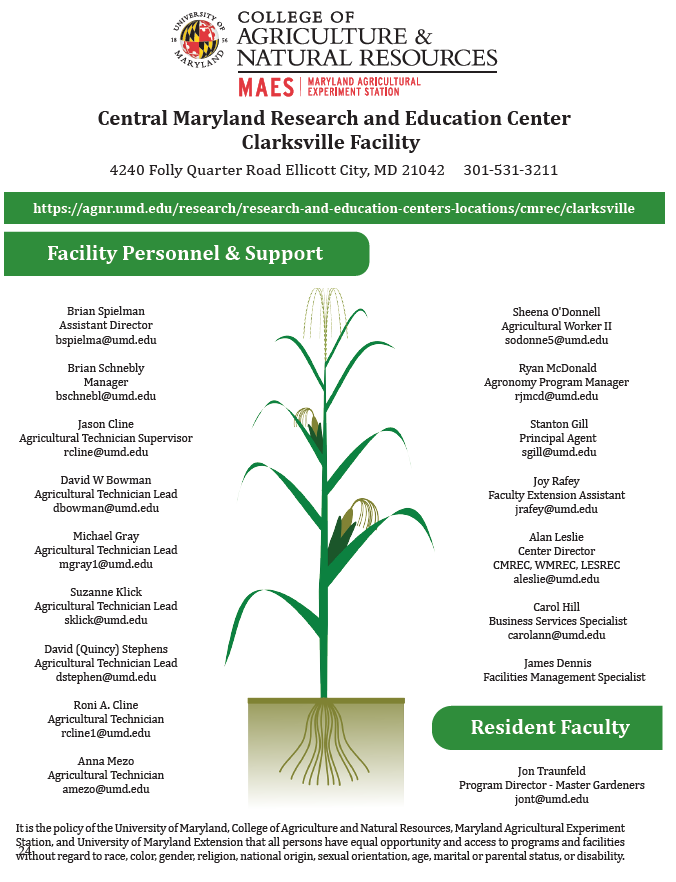'Roots in Research' Newsletter
CMREC - Clarksville Facility - Yield Year 2023
 To view this newsletter electronically, scan the QR code!
To view this newsletter electronically, scan the QR code!
Download PDF of Roots in Research
The 2023 growing season can be summed up in a single word: “dry.” Changes in rainfall patterns and hot, dry summers are just one of the stresses that MD farmers can expect to face under a changing climate. Many of the research projects carried out at the UMD RECs are helping to find solutions to help farmers cope with drought stress and other climate change factors. From genetic improvements to crops and alternative crop rotations, to cover crop management and climate monitoring, the studies carried out at our RECs are designed to ensure the success of MD agriculture through adaptive and resilient cropping strategies. Enjoy this summary highlighting the hard work that UMD researchers are doing in pursuit of solutions to agriculture’s most pressing problems.
Alan Leslie
MAES Center Director
WMREC | CMREC | LESREC
____________________________________________________________________________________________________________________________________
Clarksville Weather Station
Weather data for Poplar Hill and Salisbury are displayed on our website. The information can be displayed by month, or by the year in a printable format. To compare weather data averages by the month or year, check out our website! If your research requires this data in a different format, please contact Sheila Oscar and she will help to get the information you are requesting.
____________________________________________________________________________________________________________________
New Building at Clarksville CMREC

This year we are all eager to see the doors finally open on the new building that will serve as CMREC headquarters. This 13,000 ft 2 building will provide us modern office spaces to replace the aging facilities off Homewood Drive and bring together the faculty and staff from MAES and the UME Home and Garden Information Center and Commercial Horticulture Program. We also look forward to welcoming new faces, with new specialists in Urban Agriculture, Entomology and IPM, Residential Landscaping, and Native Plants.
In addition to the greatly improved office space, the new building will facilitate holding workshops, classes, and seminars with its new classroom space and teaching laboratory. The classroom holds nearly 100 participants or being divided into 3 smaller rooms and is fully equipped with screens, cameras, and microphones to enable virtual or hybrid workshops. The teaching laboratory is a unique workspace within MAES and will function both as a diagnostic laboratory to support commercial horticulture clientele and as a space for hands-on workshops in disease diagnosis, microbiology, and other lab-based lessons. We look forward to hosting a diverse array of educational programming here at CMREC-Clarksville as these new teaching resources become available.
The new headquarters building will be sure to bring some big changes to the CMREC- Clarksville facility as people move into their new offices, workshops and classes are finally held, and more field day events are planned and hosted. There is bound to be a period of adjustment for the farm crew getting used to the increase in traffic and the UME faculty and staff learning the sites, sounds, and smells of the dairy facility, but these changes are bound to result in a net positive for the facility. Already there are plans and discussions about adding additional trials and demonstrations in the “organic field” adjacent to the building, planning new training opportunities, and bringing additional programming to this location. I am grateful for the investment that AGNR has made in the CMREC-Clarksville location, and I look forward to future investment by MAES and UME faculty and staff.
___________________________________________________________________________________________________

____________________________________________________________________________________________________________________
Hybrid Hazelnuts for Maryland Growers as an Alternative Crop for Maryland Growers
David Clement, Extension Specialist in Pathology, HGIC, University of Maryland Extension
Stanton Gill, Extension Specialist in Entomology and IPM, CMREC, University of Maryland Extension, CMREC
Andrew Ristvey, Extension Specialist, Nutrition and Water Management Specialist, Commercial Horticulture, University of Maryland Extension WYEREC
Situation: Maryland growers are in a unique position to produce and market new crops for local markets. The crop were are proposing can be sold at farm markets, pick your own, local restaurant and caterer sales are new to Maryland is Hybrid hazelnut trees. Disease resistant hazelnuts can be trees that Maryland nurseries can grow and sell to landscapers for installing into landscapes as an edible nut tree.
European hazelnuts , Corylus avellane, produces a high quality nut that be eaten fresh or use in baked goods. Demand for these nuts are strong and Oregon has been the lead state to produce these nuts for sale in the United States. What has inhibited growth of European type hazelnuts on the East coast has been a devasting disease called filbert blight(Hazelnut=filbert) caused by Eastern Filbert Blight, also known as EFB, is a fungal disease that is native to a wide area in eastern North America. Here it is found naturally associated with its host, native American hazelnut (C. americana), on which it causes only limited damage. However, EFB causes severe cankering, branch die-back and death of susceptible European hazelnuts (C. avellana). The primary limiting factor for growth of commercial European hazelnuts is EFB susceptibility. Read more>>>
____________________________________________________________________________________________________________________
Efficacy of Turf Organic Herbicides
Kelly Nichols | kellyn@umd.edu | University of Maryland Extension, Montgomery County
Background
In some areas of Maryland, synthetic pesticides are restricted or banned for use in home lawns. This study was conducted in order to research the efficacy of some turf organic herbicides. These trials included both pre- and post-emergent control.
Pre-Emergent Trial
This trial focused on pre-emergence control of crabgrass (Digitaria sanguinalis [L.] Scop) using a corn gluten product with a nitrogen percent that complies with the Maryland Fertilizer Law. (This law limits the amount of nitrogen that can be applied to turf.)
Methods
Two rates of the corn gluten product were included, along with a nitrogen fertilizer only and standard treatments for comparison (Table 1). Treatments were placed in a randomized complete block design with three replications. Individual plots measured five feet by five feet. The first application was made on April 4, prior to crabgrass emergence. A second application of all treatments was applied on May 16. Read more>>>
__________________________________________________________________________________________________________________
Research Update: Effect of Soil Fertility on Triticale Yield and Quality
Amanda Grev, PhD, Forage and Pasture Specialist, University of Maryland Extension Jeff Semler, Principal Agent, University of Maryland Extension
It is well known that cover crops can provide many benefits in terms of soil health and nutrient retention, but in addition to this, winter forages can also serve as a high yielding and high quality forage crop for feeding livestock. Winter forages like triticale have been found to yield 2 to 6 tons of dry matter per acre and can produce forage with 180+ RFQ (relative forage quality) and 17 to 20% CP (crude protein). As a result, triticale silage has become a popular forage choice for many dairy producers to increase forage supply. Read more>>
__________________________________________________________________________________________________________________
2023 Maryland Soybean Fungicide Efficacy Trials
Andrew Kness, Senior Agriculture Extension Agent, University of Maryland Extension, akness@umd.edu
JUSTIFICATION
Fungicides are becoming increasingly popular in full season soybean production. These trials provide data that soybean producers can benefit from, such as: fungicide efficacy for managing common fungal diseases of soybean, monitor fungicide resistant pest populations, and track the economic impact of foliar fungicide applications over multiple years and environments unique to Maryland.
RESEARCH OBJECTIVES
1. Evaluate the efficacy of select foliar fungicides on full season soybeans grown on two research farms in Maryland by measuring foliar disease incidence and severity.
2. Determine any greening or green stem effects of the fungicides.
3. Monitor fungicide active ingredient efficacy over time and identify any fungicide insensitive foliar fungal pathogens.
4. Determine the yield impact of foliar fungicides and their economic impact. Read more>>
____________________________________________________________________________________________________________________

UMD Bee Lab and the New UMD Bee Squad
https://www.umdbeelab.com/ https://umdbeesquad.com/
About The Lab
The Honey Bee Lab at the University of Maryland has diverse personnel with multidisciplinary scientific backgrounds who bring a fresh perspective to solving problems. Research in the laboratory is focused on an epidemiological approach to honey bee health. We are proud to share our research into the major mechanisms that are responsible for recurring high loss levels in honey bee populations, such as pests and pathogens associated with honey bees, loss of natural forage habitat due to large monocultural croplands, and pressure from human induced changes in the environment.
Our team has led and managed the USDA APHIS National Honey Bee Disease Survey since 2009. We are also a major partner and founding member of the Bee Informed Partnership (BIP), who collaborates closely with beekeepers from across the country to study and better understand the loss in honey bee colonies in the United States.
You can find Realtime results about these efforts at our database portals: https://research.beeinformed.org/state_ reports/ Click here to purchase UMD Honey
__________________________________________________________________________________________________________________________________
Farm Tour for the National Cooperative Business Association
Kelly Nichols | kellyn@umd.edu | University of Maryland Extension, Montgomery County
On October 2, 2023, University of Maryland Extension hosted a farm tour for National Cooperative Business Association members as part of their pre-conference activities. Eleven members attended. Tour stops included farms and ag businesses in Howard and Montgomery Counties. The full list of tour stops is below.
1. The Roving Radish, Howard County’s meal kit service. Led by manager James Zoller, attendees learned how locally and regionally grown foods are sourced, how the meal kits are distributed to those who live, work, and play in Howard County, and how this is one step to increasing local food access at affordable prices.
2. Larriland Farm, an orchard and vegetable farm owned and operated by the Moore family since 1973. Attendees learned about fruit production, the opportunities and challenges with running a family business, and they also had the opportunity to pick their own apples.
3. The Central Maryland Research & Education Center (CMREC) in Clarksville. Attendees learned about the University’s dairy farm, the role of research centers in university-led research, and current research including a grazing study with annual forages and a hazelnut and truffle study. Brian Spielman, farm manager, Dave Clement, Extension pathology specialist, and Amanda Grev, Extension forage specialist presented.
4. Lone Oak Brewing Company, a relatively new on-farm brewery which grows some of the barley on the farm. Led by co-owner Chris Miller, attendees learned about the beer-making process and the opportunities and challenges with on-farm alcohol production in central Maryland.
 __________________________________________________________________________________________________________________
__________________________________________________________________________________________________________________
Research Update: Performance of Dairy Heifers on Pasture Relative to TMR-fed Counterparts
Amanda Grev, Ph.D., Forage and Pasture Specialist, University of Maryland Extension Jeff Semler, Principal Agent, University of Maryland Extension
Over the past several years, a study was completed at the Central Maryland Research and Education Center Clarksville Dairy farm to investigate the effects of improved grazing management on pregnant dairy heifer performance. The objectives were to determine the effect of improved grazing management on heifer growth characteristics, as well as the economic feasibility of using a rotational grazing system to mitigate costs associated with the replacement program. Heifers are also being followed through their first lactation to investigate potential carry-over effects on first lactation performance.
Methods
Pregnant Holstein dairy heifers (n=166; 2021-2023) from the University of Maryland Dairy were utilized for this study. Heifers were enrolled in the study on a rolling basis, with heifers added following pregnancy confirmation and removed approximately 3 weeks prior to calving. Read more>>
__________________________________________________________________________________________________________________
